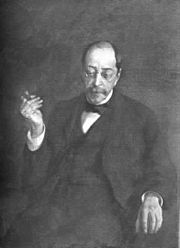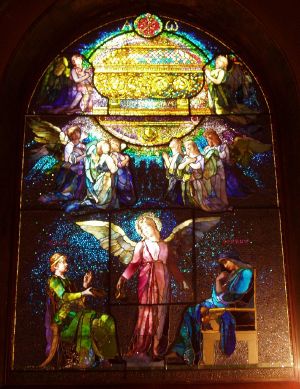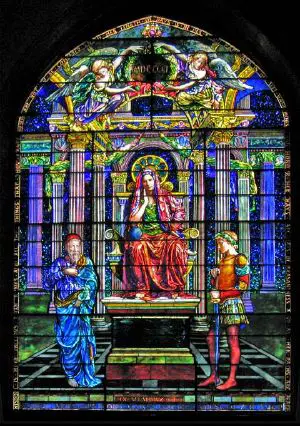Difference between revisions of "John LaFarge" - New World Encyclopedia
David Doose (talk | contribs) (Imported, version #, categories) |
David Doose (talk | contribs) (Fix) |
||
| Line 21: | Line 21: | ||
}} | }} | ||
| − | '''John La Farge''' ( | + | '''John La Farge''' (March 31, 1835 – November 14, 1910) was an [[United States|American]] painter, stained glass window maker, decorator, and writer. |
Born in [[New York City]], [[New York]], his interest in art was aroused during his training at [[Mount St. Mary's University]]<ref>{{cite web|url=http://www.emmitsburg.net/archive_list/articles/ce/mount/2003/painting_exhibit.htm|title=Works by Mount Saint Mary's Alumnus to be Featured in Exhibit|publisher=emmitsburg.net|accessdate=2007-07-06}}</ref> and St. John's College (now [[Fordham University]]). He had only the study of law in view until he returned from his first visit to [[Paris]], [[France]] where he studied with [[Thomas Couture]] and enjoyed the most brilliant literary society of the day. Even his earliest drawings and landscapes, done in [[Newport, Rhode Island]], after his marriage in 1861 to Margaret Mason Perry, sister-in-law of [[Lilla Cabot Perry]], show marked originality, especially in the handling of color values, and also the influence of [[Japan]]ese art, in the study of which he was a pioneer. | Born in [[New York City]], [[New York]], his interest in art was aroused during his training at [[Mount St. Mary's University]]<ref>{{cite web|url=http://www.emmitsburg.net/archive_list/articles/ce/mount/2003/painting_exhibit.htm|title=Works by Mount Saint Mary's Alumnus to be Featured in Exhibit|publisher=emmitsburg.net|accessdate=2007-07-06}}</ref> and St. John's College (now [[Fordham University]]). He had only the study of law in view until he returned from his first visit to [[Paris]], [[France]] where he studied with [[Thomas Couture]] and enjoyed the most brilliant literary society of the day. Even his earliest drawings and landscapes, done in [[Newport, Rhode Island]], after his marriage in 1861 to Margaret Mason Perry, sister-in-law of [[Lilla Cabot Perry]], show marked originality, especially in the handling of color values, and also the influence of [[Japan]]ese art, in the study of which he was a pioneer. | ||
| Line 61: | Line 61: | ||
*Adams, Foster, La Farge, Weinberg, Wren and Yarnell, ''John La Farge'', [[Abbeville Publishing Group (Abbeville Press, Inc.)]], NY, NY 1987 | *Adams, Foster, La Farge, Weinberg, Wren and Yarnell, ''John La Farge'', [[Abbeville Publishing Group (Abbeville Press, Inc.)]], NY, NY 1987 | ||
*[[Royal Cortissoz|Cortissoz, Royal]], ''John La Farge: A Memoir and a Study'', [[Houghton Mifflin Company]], Boston 1911 | *[[Royal Cortissoz|Cortissoz, Royal]], ''John La Farge: A Memoir and a Study'', [[Houghton Mifflin Company]], Boston 1911 | ||
| − | * Forbes, David W., "Encounters with Paradise: Views of Hawaii and its People, 1778-1941" | + | * Forbes, David W., "Encounters with Paradise: Views of Hawaii and its People, 1778-1941," Honolulu Academy of Arts, 1992, 201-220. |
*Gaede, Robert and Robert Kalin, ''Guide to Cleveland Architecture'', Cleveland Chapter of the American Institute of Architects, Cleveland OH 1991 | *Gaede, Robert and Robert Kalin, ''Guide to Cleveland Architecture'', Cleveland Chapter of the American Institute of Architects, Cleveland OH 1991 | ||
*Kowski, Goldman et al, ''Buffalo Architecture:A Guide'', [[The MIT Press]], Cambridge MA 1981 | *Kowski, Goldman et al, ''Buffalo Architecture:A Guide'', [[The MIT Press]], Cambridge MA 1981 | ||
Revision as of 14:16, 18 January 2009
| John LaFarge | |
 John La Farge, 1902 | |
| Born | March 31 1835 New York City, New York |
| Died | November 14 1910 (aged 75) |
| Nationality | American |
| Field | Painting, Stained glass art, Decorator, Writer |
| Training | Mount St. Mary's University |
John La Farge (March 31, 1835 – November 14, 1910) was an American painter, stained glass window maker, decorator, and writer.
Born in New York City, New York, his interest in art was aroused during his training at Mount St. Mary's University[1] and St. John's College (now Fordham University). He had only the study of law in view until he returned from his first visit to Paris, France where he studied with Thomas Couture and enjoyed the most brilliant literary society of the day. Even his earliest drawings and landscapes, done in Newport, Rhode Island, after his marriage in 1861 to Margaret Mason Perry, sister-in-law of Lilla Cabot Perry, show marked originality, especially in the handling of color values, and also the influence of Japanese art, in the study of which he was a pioneer.
La Farge's inquiring mind led him to experiment with color problems, especially in the medium of stained glass. He succeeded not only in rivaling the gorgeousness of the medieval windows, but in adding new resources by his invention of opalescent glass and his original methods of superimposing and welding his material. Among his many masterpieces are the "Battle Window" at Harvard and the cloisonné "Peacock Window" in the Worcester Art Museum. Two of his largest windows are located in Unity Church in North Easton, Massachusetts. The earliest of these, the "Angel of Help" was completed in 1887 while the "Figure of Wisdom" dates to 1901. Both of these windows were restored by "Victor Rothman for Stained Glass Inc" of Yonkers, New York in the 1990's.
Between 1859 and 1870, he illustrated Tennyson's Enoch Arden and Robert Browning's Men and Women. Breadth of observation and structural conception, and a vivid imagination and sense of color are shown by his mural decorations. His first work in mural painting was done in Trinity Church, Boston, in 1873. Then followed his decorations in the Church of the Ascension (the large altarpiece) and St. Paul's Church, New York. For the State Capitol at St. Paul he executed, in his seventy-first year, four great lunettes representing the history of religion, and for the Supreme Court building at Baltimore, a similar series with Justice as the theme. In addition there are his vast numbers of other paintings and water colors, notably those recording his extensive travels in the Orient and South Pacific.
His labors in almost every field of art won for him from the French Government the Cross of the Legion of Honor and membership in the principal artistic societies of America, as well as the presidency of the National Society of Mural Painters from 1899 through 1904. Enjoying an extraordinary knowledge of languages (ancient and modern), literature, and art, by his cultured personality and reflective conversation he greatly influenced all who knew him. Though naturally a questioner he venerated the traditions of religious art, and preserved always his Catholic faith and reverence.
In 1904, he was one of the first seven chosen for membership in the American Academy of Arts and Letters. On his passing in 1910, John LaFarge was interred in the Green-Wood Cemetery in Brooklyn, New York. During his life, he maintained a studio at 51 West 10th Street, in Greenwich Village, which today is part of the site of Eugene Lang College.[2]
Children
His eldest son, Christopher Grant LaFarge, was a partner in the New York-based architectural firm of Heins & LaFarge, responsible for projects in Beaux-Arts style, notably the original Byzantine Cathedral of St. John the Divine, the Yale undergraduate society St. Anthony Hall (extant 1893-1913) pictured at,[3] and the original Astor Court buildings of the Bronx Zoo.
His son Oliver Hazard Perry LaFarge I became an architect and real estate developer. Part of his career in real estate was in a Seattle partnership with Marshall Latham Bond, Bond & LaFarge. During the year 1897 to 1898 Seattle real estate which had gone through a bubble was in a slump. The partners left and participated in the Klondike Gold Rush. Among the camp fire mates at Dawson City during the Fall of 1897 was Jack London who rented a tent site from Marshall Bond. In Seattle the Perry Building designed after LaFarge returned is still standing. Later on in life O.H.P. LaFarge designed buildings for General Motors.
Another of his sons, John LaFarge S.J. became a Jesuit priest and a strong supporter of anti-racial policies. He wrote several books and articles before the war on this subject, one of which caught the eye of Pope Pius XI who summoned him to Rome and asked him to work out a new encyclical, Humani Generis Unitas, against Nazi policies. John LaFarge completed work on the encyclical, but unfortunately it reached the pope only three weeks before the pope's death. It remained buried in the Vatican archives and was only rediscovered a few years ago. John LaFarge S.J. was born February 13, 1880 and died November 25, 1963. His most famous books are The Manner is Ordinary (1953), Race Relations (1956), and Reflections on Growing Old (1963).
Selection of LaFarge's writings
- The American Art of Glass (a pamphlet)
- Considerations on Painting (New York, 1895)
- An Artist's Letters from Japan (New York, 1897)
- The Great Masters (New York)
- Hokusai: a talk about Japanese painting (New York, 1897)
- The Higher Life in Art (New York, 1908)
- One Hundred Great Masterpieces
- The Christian Story in Art
- Letters from the South Seas (unpublished)
- Correspondence (unpublished)
Notes
- ↑ Works by Mount Saint Mary's Alumnus to be Featured in Exhibit. emmitsburg.net. Retrieved 2007-07-06.
- ↑ Kenneth T. Jackson:The Encyclopedia of New York City: The New York Historical Society; Yale University Press; 1995. P. 650.
- ↑ Yale's Lost Landmarks at www.yalealumnimagazine.com
ReferencesISBN links support NWE through referral fees
- Adams, Foster, La Farge, Weinberg, Wren and Yarnell, John La Farge, Abbeville Publishing Group (Abbeville Press, Inc.), NY, NY 1987
- Cortissoz, Royal, John La Farge: A Memoir and a Study, Houghton Mifflin Company, Boston 1911
- Forbes, David W., "Encounters with Paradise: Views of Hawaii and its People, 1778-1941," Honolulu Academy of Arts, 1992, 201-220.
- Gaede, Robert and Robert Kalin, Guide to Cleveland Architecture, Cleveland Chapter of the American Institute of Architects, Cleveland OH 1991
- Kowski, Goldman et al, Buffalo Architecture:A Guide, The MIT Press, Cambridge MA 1981
- Waern, Cecilia, John La Farge: Artist and Writer, Seeley and Co. Limited, London 1896
External links
This article incorporates text from the public-domain Catholic Encyclopedia of 1913.
Credits
New World Encyclopedia writers and editors rewrote and completed the Wikipedia article in accordance with New World Encyclopedia standards. This article abides by terms of the Creative Commons CC-by-sa 3.0 License (CC-by-sa), which may be used and disseminated with proper attribution. Credit is due under the terms of this license that can reference both the New World Encyclopedia contributors and the selfless volunteer contributors of the Wikimedia Foundation. To cite this article click here for a list of acceptable citing formats.The history of earlier contributions by wikipedians is accessible to researchers here:
The history of this article since it was imported to New World Encyclopedia:
Note: Some restrictions may apply to use of individual images which are separately licensed.


